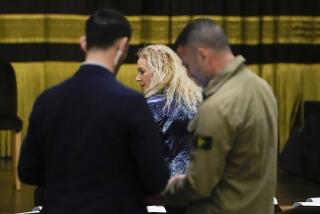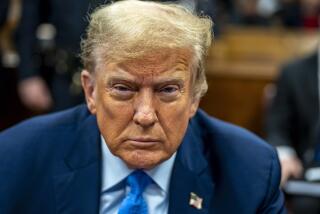Mafia’s ‘Boss of Bosses’ Arrested in Sicilian Dragnet
PALERMO, Sicily — The long-sought fugitive “godfather” of the Sicilian Mafia was arrested in a police dragnet Thursday, giving an unexpected twist to the extraordinary mass trial here of 467 Mafia bosses, murderers, drug traffickers, racketeers, money-launderers and hangers-on.
Michele Greco, undisputed “boss of bosses” in Palermo and acknowledged top leader of the entire Sicilian criminal syndicate, was found with his wife at a farmhouse near Palermo, where police said the two were living with forged identity papers.
The 62-year-old mob leader, known as il papa (the pope), is believed to be the chairman of the 12-man commission of Mafia bosses governing such matters as murders, especially those of public officials, and major moves in the syndicate’s $4-billion-per-year drug trade.
In Hiding Since 1982
Although still active as a leader until Thursday, Greco has been in hiding since 1982. He was one of 115 fugitives being tried in absentia in the extraordinary “maxi-trial” of 467 Mafiosi that opened here last week. Of the defendants, 220 are in jail, about 60 are under house arrest and more than 70 are free on their own recognizance, according to prosecuting attorney Domenico Signorino.
Law enforcement officials said that Greco was one of 25 criminal suspects picked up in an island-wide sweep by hundreds of policemen, some of them using helicopters, early Thursday morning.
His brother, Salvatore, 58, also a fugitive defendant in the mass trial, remains at large, police said. Michele and Salvatore, whose nickname is “the senator,” were sentenced in absentia to life in prison in 1984 for the car-bomb assassination of anti-Mafia Judge Rocco Chinnici. That killing was one of a number of murders of public officials that brought about the current anti-Mafia campaign throughout Italy.
In the mass trial now proceeding in a specially built, bunker-like courtroom here, both Grecos are charged with numerous killings, including the shooting of Italy’s most respected anti-Mafia policeman, Gen. Carlo Alberto Dalla Chiesa, and his young wife in September, 1982. They also are charged with drug trafficking and, in common with 315 of their fellow defendants, with Mafia membership, which has been a crime in Italy since 1982.
Money From Drug Deals
Michele Greco’s son, Giuseppe, is also one of the defendants. He is charged with laundering money gained from drug deals.
Officials said they immediately sent word of Greco’s arrest to Italian Prime Minister Bettino Craxi, who was meeting with West German Chancellor Helmut Kohl in Bonn. Before the mass trial began on Feb. 10, Craxi had hailed it as “the symbol of this defeat (of the Mafia.)” But other officials, including former Palermo Judge Aldo Rizzo, now a member of the parliamentary anti-Mafia commission, cautioned that as long as Greco, “the head of the serpent,” remains at large, the mob “is still capable of showing its criminal power.”
One jubilant police official in Palermo hailed the Greco arrest as “the most important break in years” in the struggle against the Mafia.
But Palermo’s new reform mayor, Leoluca Orlando, 39, stressed in an interview that despite the importance of some of the defendants, “this is not the trial to end the Mafia, it is only an important trial against an important piece of the Mafia.”
The extraordinary “maxi-trial,” as the Italian press has called it, is expected to last for at least a year and cost a minimum of $100 million. That includes the $19 million paid for the hurried construction of a huge concrete-and-steel, technologically equipped courtroom, which is connected by tunnels to the 170-year-old Ucciardone prison.
Prosecutors, two regular judges and two alternate judges involved in the trial said it was necessary to try the first batch of indicted Mafiosi en masse in order to untangle the complexity of their world-wide operations, including their “pizza connection” and other criminal links to the American Mafia.
“The connection between defendants is so intricate, with drug trafficking, money-laundering and so forth,” said Signorino. “Of necessity, we had to do this maxi-trial to be able to show the global picture and the interrelationships of these people.”
But he added that the procedure has proved so unwieldy that a number of the defendants may be freed. Under Italian law, the state has one year from the filing of an indictment to complete a trial for a relatively minor crime, such as criminal association, and 18 months to wind up trials on serious charges.
About 70 of the Mafia defendants are charged only with criminal association and their trial deadline is Nov. 8, which Signorino said he doesn’t believe the court can meet. Thus he expects the 70 to go free, and all the rest as well if the state cannot wind up its entire case by May 8, 1987.
“Our judicial machinery wasn’t invented for such a mega-trial,” he said, while expressing hope that the more significant May deadline will be met.
Pretrial Proceedings
Signorino said that about 500 more suspected Mafiosi already are the subjects of pretrial proceedings and will be indicted and tried later this year and next year in smaller and more manageable batches.
In the courtroom, meanwhile, the trial’s early days have gone at a snail’s pace, as more than 300 defense lawyers seeking to be heard vie with 30 to 40 other lawyers representing survivors of Mafia victims seeking to file civil damage suits. Under Italian law, the civil suit may be tried along with the criminal charges.
Among the victims is the city of Palermo, which Mayor Orlando said wants compensation for the loss of tourism and local business, as well as for the cost of repairing streets blown up by Mafia car bombs and the cost of guarding judges, jurors, prosecutors and other public officials, including the 30-man police detail needed to protect him and his family.
Court officials are uncertain just how much money and other assets they have legally sequestered from the defendants, but estimates run into hundreds of millions of dollars, creating a significant pool for the payment of civil judgments if the Mafiosi are convicted and the civil suits are heard at the same time.
Swiss Bank Account
One of the defendants, Tommaso Spadaro, is said in the 8,636-page trial indictment to have laundered more than $500 million, the receipts of U.S. drug sales, through a Swiss bank account in Lugano between 1981 and 1983.
Among other leading Mafia figures behind the heavy steel bars that front the 30 defendants’ cages in the arena-like courtroom is Luciano Leggio, who remains the “boss of bosses” of the crime family of Corleone, the Sicilian hill town from which Mario Puzo drew names and background for his best-selling novel, “The Godfather.”
Leggio, 61, has been serving a life sentence in a prison on the island of Sardinia since 1974, yet has managed to remain in day-to-day control of his crime families. Not surprisingly, police refer to him as “the management genius of the Mafia.” He is charged with four murders.
Another is Giuseppe (Pippo) Calo, 55, a mob financial specialist and, like Leggio and Greco, a member of the ruling commission, who is said to have had links with the Italian secret service before he went into hiding 15 years ago. He was arrested last March and faces charges in a string of murders.
The crescent of 30 barred defendants’ cages that is the backdrop of the two-tone green courtroom is lightly populated most days, with rarely more than 100 of the accused men present, chatting, smoking and, in at least some cases, looking more like skylarking business executives than criminals on trial.
Three of the cages are reserved for 30 special defendants, just to the left of the sweeping judicial bench that accommodates the four judges, 16 jurors, two prosecuting attorneys and two other court officials.
Penitents Separated
The special defendants are the pentiti, penitents who broke with the mob and confessed to a variety of crimes, linking their former companions--”men of honor” the Mafia men call themselves--to the crimes with which they are presently charged.
So far during the trial’s slow-moving early days, only three of the pentiti have sat in on a session, but when the prosecution begins laying out its case, probably sometime in March, they are expected to be called upon frequently, Signorino said.
Chief among them is Tommaso Buscetta, himself a one-time “godfather” who turned state’s evidence after inter-family fights within the mob took the lives of his two sons, two brothers, two nephews, a son-in-law and scores of close friends.
Buscetta and another penitent Mafioso, Salvatore Contorno, are in New York under a joint Italy-U.S. crime-fighting treaty, testifying against U.S. and Italian Mafia figures in the Pizza Connection trial. Both are expected to return when their testimony is needed in the mass trial here.
More to Read
Sign up for Essential California
The most important California stories and recommendations in your inbox every morning.
You may occasionally receive promotional content from the Los Angeles Times.










